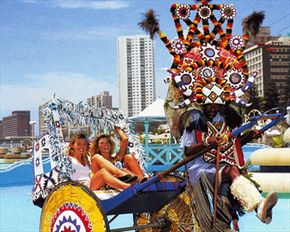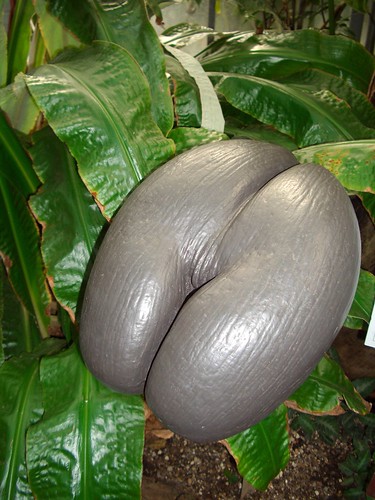OK, it's a fair cop! It was no coincidence that I happened to hang around in South Africa whilst the World Cup was on. To be honest I would have moved on earlier but I had all these "You give £2 a month to feed the poor in Africa and they use it to buy a f*cking trumpet" t-shirts to get rid of. I had a feeling that they wouldn't sell and eventually ditched them so I was soon able to depart the shores of Africa en route to the mysterious island of Madagascar.
One thing about Durban I must share with you are these chappies; the Zulu rickshaw pullers.

Now, this makes a pleasant change from the decorated transport in our fair land which, at best, can be described as bland. Furry dice, and "Beware, Princess on Board" & "My other car is also a piece of junk" stickers are hardly high art now, are they? Oh, for the days of the tiger tail sticking out of one's petrol tank!
Climbing into my trusty G-BERT and leaving a few rand for my ground crew, I set off across the Mozambique Channel to the town of Toliara, some 800 nautical miles away. It was so nice to be in the air again. - the freedom of the skies and the coastline slowly slipping away as I flew into a clear blue future. Four hours later and the coastline of Madagascar was in sight. The navigation worked!! Antananarivo ATC picked me up and vectored me in for a nice simple landing and I had arrived at last at an island which has always fascinated me.

To be honest, it's nothing like the movie but there you go. Becauseof its unique position, Madagascar has an unsurpassed collection of flora and fauna. Of the 10,000 plant species there, some 90% are found nowhere else in the world whilst the animal life has evolved separately to the rest of the world also - lemurs being a prime example. Tragically, mining and slash & burn foresting techniques are destroying a lot of the irreplaceable habitat and there seems little governmental pressure to limit this. It's estimated that 10% of the original forest habitat remains. Interestingly, only about 45% of the country are Christian with the majority of inhabitants practising Malagasy mythology, a traditional religion which emphasizes the links between living and dead. There is little doubt that the country would be classified as "third world" and it is shunned by many other countries due to the undemocratic nature of its military regime and ongoing civil war. All in all, not the best place in which to hang around.
Toliary itself was not the most exciting place so I decided to press on to the north of the island and the small airport at Sambava before pressing further northwards to the delights of the Seychelles. I paused to collect some of the new currency, the Ariary, which replaced the franc back in 2005. This is all a bit tragic as their banknotes were still influenced by the French ancestry (colonial French notes being predominantly delicate pastel shades and beautiful engraving). Now, the new notes are unprepossessing and dour, emulating how their country is becoming.

-donatedta_b.jpg)
OK, off we go to the island paradise that is the Seychelles. A long 7 hour flight with only the sea and my built-in MP3 player for company. I tried my in-flight video camera and, as you can see, the controls aren't quite second nature yet! Still. I made it and that's the main thing.
The Seychelles - 115 islands and historically a transit point for trade between Africa and Asia and named after Jean Moreau de Séychelles, Louis XV's Minister of Finance. Britain nicked them back in 1810 although independence was granted in 1976. In true African style, there was a coup d'etat within a year although the islands has been democratically governed since 1991.
Obviously the islands are beautiful and an Eden for watersports as well the home of giant tortoises and the only flightless bird in the Indian Ocean (the White-Throated Rail). Mind you, who in their right mind would want to leave this paradise? Apparently the treasure of the notorious pirate Olivier de Vasseur (La Buze) is apparently buried somewhere in North Mahé. This is valued at $160,000,000 so I shall be buying a bucket and spade.
One other strange piece of flora peculiar to the Seychelles is the coco de mer, a species of palm indigenous to the islands. It gained a reputation amongst sailors as its floating seed resembles the disembodied buttocks of a woman and they spread wild tales of its origin. Personally, I would have said front bottom was more pertinent.

What think you? Dial 0858 123000 followed by the number 1 for bottom or 2 for whatever euphemism you care to use. I think "daisy" is rather nice. Until the true source of the nut was discovered in 1768, it was believed by many to grow on a mythical tree at the bottom of the ocean. European nobles in the sixteenth century would often have the shells of these nuts polished and decorated with valuable jewels for their own private galleries.
It's undoubtedly a place of magical beauty but I must travel onward. In order to reach the Persian Gulf I need to dog leg back to Africa and the country of Somalia as the straight route is not possible without finding a fuel station on the way. Perhaps I ought to Google "Indian Ocean service stations"?


.jpg)

.jpg)


1 comment:
What a fab blog post Bertie - I really enjoyed that. As you know, I visited Jersey recently, and at the Wildlife Conservation Trust there, there is a whole section devoted to animal and bird species from Madagascar. Many of them are 'critically endangered', as although the hunting and killing of these animals is illegal, in practice little is done to stop it. Lemurs, for example, are often hunted as a food for the poorer countrymen of Madagascar.
As for Coco de Mer (she sounds like an exotic dancer), I have never seen those 'nuts' before. How extraordinary.
Keep up the good work - 'tis fab to see you writing again. :) x
Post a Comment